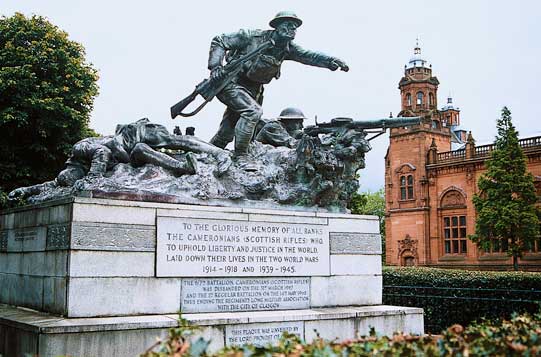By Jeannie Campbell MBE

There are many war memorials in and around Glasgow but one of the most striking is that of the Cameronians in Kelvingrove Park with its three figures of soldiers in the midst of battle.
In the summer during the week prior to the World Pipe Band Championships, many bands practice in Kelvingrove Park and band members may have seen this memorial. It is situated at the entrance to the car park of the art gallery. The three slightly larger than life figures on the granite base were sculpted by Philip Lindsey Clark (1889-1977) and cast in bronze by the Maneti Foundry in London. The Memorial was unveiled on August 9, 1924 by Field Marshal the Earl Haig KT GCB OM GCVO KCIE in the presence of a large crowd. In 1947 the inscription was changed to include those who died in the Second World War, and in 1968 a tablet was added to mark the disbandment of the regiment.
The sculpture depicts a sergeant “advancing over the top”, symbolising Victory. On his right is the dead body of a young officer, symbolising Sacrifice. A Lewis gunner (in the foreground) covers the advancing troops with gunfire and, in the words of the artist, shows the “determination to succeed … for which our men were so remarkable”.
From 1914 to 1918, 27 battalions of The Cameronians (Scottish Rifles) served in the First World War. The Regiment was heavily involved on the Western Front, in Gallipoli and the Middle East, and in Salonika. During the war, more than 7,000 of its men lost their lives, and an estimated 11,000 men were injured. After the war, operational service followed in China, Egypt, India, Iraq and Palestine. When the Second World War broke out in 1939, The Cameronians mobilised six active battalions. The 1st Battalion was stationed in India, training Indian soldiers and providing internal security. Their position became important in defending Burma from Japanese occupation between 1942 and 1944. The 2nd Battalion was sent to France where they were involved in heavy fighting at Dunkirk, until evacuated in June 1940. In 1943, the 2nd took part in the assault on Sicily, the first step in the invasion of Italy. Later, they were sent to Germany, joining soldiers of the 6th, 7th and 9th Battalions, who had been serving in northwest Europe since 1944. An official disbandment ceremony took place on May 14, 1968 at Douglasdale, Lanarkshire. The date and location were significant, marking the anniversary of the raising of the regiment in Douglas in 1689.
Many years ago when walking through the park, Pipe Major Angus MacDonald MBE pointed the memorial out to me. He told me the central figure was his teacher, Pipe Major Sanderson. Angus’s mother died when he was only nine years old and his father, a Glasgow policeman, was left with two young children. Angus was sent to board at the Queen Victoria School at Dunblane and his young sister went to live with an aunt. At the school Sanderson taught Angus piping before the youngster joined the Scots Guards as a boy soldier in 1953. Strangely, Angus called him George Sanderson and named him as such in a photograph that appeared in his second music collection.
During his 23 years at Queen Victoria School, Sanderson must have taught hundreds of boys but if he is remembered for nothing else he should be recognised for having taught one of the great pipers of the modern era, Pipe Major Angus MacDonald MBE, Scots Guards, who in his turn taught or influenced many others throughout the world and left us a rich legacy of music and stories.
The Pipes of War, the main source for information on pipers in the First World War, has nothing on Sanderson, and online forces records have only a couple of entries for Private J. Sanderson or Rifleman J. Sanderson of the Cameronians. However, for this article I have managed to piece together his life story from statutory registers and newspaper archives.
James Sanderson was born in 1902 at Canongate, Edinburgh and was registered as James Sanderson although later he added his mother’s maiden name of MacLennan. His parents were George Sanderson and Isabella McLennan who were married in 1901 at Canongate, Edinburgh. In the 1911 census the family was George Sanderson (aged 39), his wife Isabella (39), and their children James (8), Jane (6), John (4) and George (2).
James served with the Cameronians for 22 years and afterwards became the instructor at the Queen Victoria School from 1940 to 1963. In addition, he was the instructor to Crieff British Legion pipe band for a time until Pipe Major R. Whitelaw succeeded him in 1951. In 1959, he was awarded the B.E.M. and in the Honours List for that year he appears as ‘James McLennan Sanderson, Pipe Major, Queen Victoria School, Dunblane’. He died in 1983, aged 80, at the small town in Stirlingshire.
There are many newspaper references to Sanderson at the school and judging or playing at various events in the surrounding district. According to one article he composed a tune called Colonel A. W. H. Hay Drummond of Cromlix but this does not seem to have been published. The Stirling Observer on July 28, 1942 reported on Williamfield Highland Games: “The judges of the piping and dancing were Pipe Major Sanderson, Queen Victoria School, and Pipe Major Philliban, 1st Stirlingshire Battalion, Home Guard. Piper John Kerr played for the dancers.”
On August 14, 1945 the same newspaper gave more information on the Cameronian memorial: “An interesting personality at the Cameronians’ service of remembrance held recently at the regimental memorial in Kelvingrove Park, Glasgow, was Pipe Major James Sanderson, Queen Victoria School, Dunblane. He it was who had the distinction of being chosen as the model for the central figure on the memorial, that of a soldier in the act of advancing ‘over the top’, symbolising victory. At that time he was stationed at Aldershot, and posed for the sculptor in London. He has been pipe major at Dunblane for the past five years, prior to which he had served in the 1st Battalion of the Cameronians for 22 years.”
In 1951 the boys from the school took part in the Royal Tournament along with the massed pipes and drums of the 2nd Scots Guards, 1st Royal Scots, 1st Royal Scots Fusiliers and 1st Highland Light Infantry. The report in the school magazine, The Victorian, read: “Taking their places on eight boards ranged round the area, eight foursomes danced a Strathspey and a Reel o’ Tulloch … at the end of the dance a warm burst of applause filled the stadium, unlike the response to anything else in the Royal Tournament … The dancers wheeled round into line before the Royal Box, while as a fresh surprise to the delighted audience Pipe Major Sanderson made his superb entrance into the arena, his chest positively radiating pride in Scotland and his pupils. After the salute, the boys marched off smartly in file to Highland Laddie and disappeared in the distance through the double doors at the far end.”
The Courier and Advertiser on June 28, 1954 reported: “Band went to hospital – to play for Nicholas. Patients at King’s Cross Hospital, Dundee, were given a treat yesterday afternoon. For half an hour the band of the Queen Victoria School, Dunblane (25 pipers, ten drummers, average age 13), played on the lawn. It was all for the sake of 13 year old Nicholas Sinclair, 4 Cross Street, Perth. He was a drummer in the band until ten months ago when he took ill. Now convalescing, Nicholas heard that his schoolmates were to play in Camperdown Park. A great chance to have a word with his pals, he thought. But the doctors decided the journey might be a little too much for him. Instead, Pipe Major Sanderson was asked if the band could spare a few minutes to play at the hospital. Ward windows were hurriedly opened as the band struck up Bonnie Dundee. On a veranda, eyes glistening, stood Nicholas, clutching sweets and fruit his pals had brought to him. ‘This is great,’ he said. ‘It makes me wish I was back with them again.’ It won’t be long now before he is.”

The Strathearn Herald on September 6, 1958 reported: “Model Piper. The Cameronian War Memorial in Glasgow was re-dedicated by the Moderator of the General Assembly last Sunday and Pipe Major Sanderson of the Queen Victoria School had the honour of playing the Lament. More than 35 years ago he was chosen as model for the dominant figure which surmounts the memorial. A Cameronian for 22 years, Pipe Major Sanderson was chosen from the ranks of the 1st Bn. to pose for the regiment’s 1914-18 memorial. He is the jutting jaw, tin-helmeted Cameronian occupying the centre piece of the memorial. The memorial has been renovated and supplemented to cover the Second World War. Pipe Major Sanderson, called from his work at Q.V.S. for the re-dedication service was indeed a proud man on Sunday. He said, ‘When I looked at myself, I could have been back with the Cameronians in 1940.’”

The Strathearn Herald, January 10, 1959, reported: “Pipe Major James M Sanderson, who has gained the B.E.M., is the longest serving member of the staff at Queen Victoria Military School, Dunblane, the boarding school for the sons of Scottish soldiers, sailors and airmen. Pipe Major Sanderson was for a spell instructor to the pipe band of Crieff British Legion Branch.” On March 2, 1963, it reported: “Silver Quaich. Pipe Major J M Sanderson, B.E.M., has been on the staff of the Queen Victoria Military School, Dunblane, for the past 23 years. To mark his last appearance with the boys at a home international match at Murrayfield, the Scottish Rugby Union has presented him with a silver Quaich. The Pipe Major was at one time instructor to Crieff British Legion Pipe Band. The ‘Pipey’, as he is known to staff and boys at ‘Q.V.,’ is the oldest serving member of the staff, having been there since 1940, when he left the Cameronians after serving 21 years. He will be retiring at Christmas.”
Later that year, on September 28, the same paper reported on another outing for the band: “Q.V.S. Band. Twenty-five boys, in the Queen Victoria School Band, under the command of Pipe Major J. Sanderson B.E.M. and Drum Major A Morrison, have just returned after taking part in the sixth ‘big ship’ cruise of the National Trust for Scotland on the Devonia. The band had a very enjoyable journey to Norway and, before they left Rosyth Dockyard the boys made their mark on the cruise when they played on the quay as passengers were going up the gangways. They beat retreat magnificently in the public squares of Stavanger, Bergen, and Kirkwall (on their return) with a precision inherited from their fathers. The colourfulness of the pipe band and the infectious rhythms of the music appealed to the Norwegians just as their folk-dancing and singing appealed to Devonia’s passengers in Stavanger.”
Information on Sanderson is scarce after this date although it seems strange that no obituary appeared to mark the passing of a man who must have been well known in the Dunblane area.
• If any readers can provide more details on Pipe Major James Sanderson, please contact us in the usual way.





